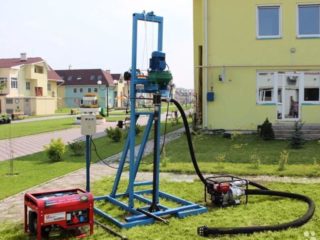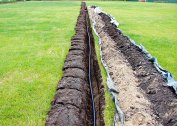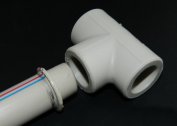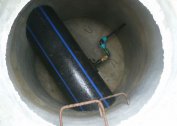Drilling water wells with small-sized installations is the only way to solve the problem of equipping the source in ennobled household plots. This is due to the compactness of the equipment, which will be placed in the yard without harm to lawns and landings.
The principle of operation and arrangement of the equipment used
The problem of pollution or lack of water in the warm season is widespread, so owners of country houses are faced with long lines at organizations specializing in well drilling. In this case, you have to make a choice: to postpone the solution to the problem for 2-3 months or proceed to eliminate it yourself.
Drilling with small-sized equipment is carried out at any time of the year, the execution technique is simple, the equipment has an acceptable cost. Experts advise buying a drilling rig, rather than renting it, because in the future it can be useful more than once. When working with an assistant, as a rule, one day is enough for re-drilling. The instruction manual is attached to the unit upon purchase.
Compact industrial equipment designed for drilling wells using auger technology. Reverse or direct flushing is used simultaneously with the immersion of the drill in the soil. There should be free space near the installation of the mobile drilling station, since the soil will be pushed to the surface as the rods deepen.
The kit includes:
- Welded frame made of high strength metal. A profile of a material with high corrosion resistance is used, the surface is coated with an active chemical composition. The width of the racks in the frame does not exceed 3.5 meters. Given the various modifications of the drilling rigs, their height ranges from 2.2 - 3.5 meters.
- Cable and winch for lifting. The latter, as a rule, can withstand a load of up to 1 ton.
- Electrical equipment: remote control, engine and control unit. The motor operates on a 220 W network. If there is no electricity on the site, internal combustion is used.
- Drilling equipment: rods, barrel and drill. Tips are made of special alloys that cope with all types of soils without much effort.
When buying equipment, they check the quality of the installation assembly, as well as the availability of the necessary documentation. Included is a step-by-step algorithm for performing work.
Work technique
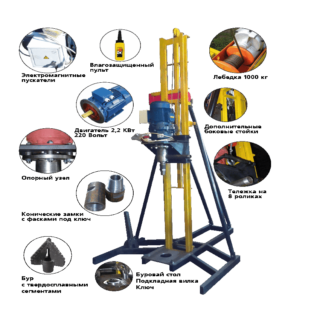 Before drilling, evaluate the composition and quality of the soil. You need to make sure that there is no accumulation of stones. Choose a suitable area for work. For the installation of drilling equipment, the site is leveled as much as possible and make sure that there will be 1.5 meters of free space in the radius around the installation.
Before drilling, evaluate the composition and quality of the soil. You need to make sure that there is no accumulation of stones. Choose a suitable area for work. For the installation of drilling equipment, the site is leveled as much as possible and make sure that there will be 1.5 meters of free space in the radius around the installation.
Before starting work, you need to dig two recesses near the site where the drilling rig will be installed. One pit will be a filter, and the second a source of fluid supply to the barrel. The pump needs to be installed near the main tank. For convenience, the bottom of the recess is best covered with a dense film. The depth should be 60-70 cm, the perimeter is 50 * 50 cm. It is required to connect these holes with a small trench along which the liquid from the filter will be transported to the main pit.
Assembling a mobile drilling rig can be done by one person, usually the time spent does not exceed 1 hour. The hose must be connected to the pump.
After starting the rig, you need to carefully monitor the angle of inclination at which it enters the ground. The tip should be immersed in the surface layer strictly vertically.You can monitor the angle using the usual building level. After the first soil layer is overcome, the first rod is removed by reverse, the drilling rig is lifted and a new second rod is installed. Work is carried out using an electric motor. Gradually, as the earth passes, the rod is extended to the desired depth.
During operation, it is necessary to regularly remove dirt from the filter pit, monitor the composition of the liquid: when changing the breed, it is necessary to replace the soil solution.
Aquifer signs
Drilling with small-sized installations allows you to continuously monitor the depth of immersion. The main signs indicating a deepening in an aquifer:
- Decreased solution level in the pit.
- A sharp increase in the speed of immersion of the unit in the thickness of the earth.
- Amplification of vibration - it seems that the drill simply falls into the ground.
- Sand impurities appear in the filter pit.
After reaching the required depth, it is important to flush the barrel with a pump. The final stages are to dismantle and disassemble the rods. After removing the rig, proceed with the installation of the casing. The end must be equipped with a filter so that the pumped water contains a lower concentration of silt, small algae, sand and other solid impurities.
Advantages and disadvantages of the method
Equipment owners note the following advantages:
- Mobility and low installation weight. The total mass of all components of the kit does not exceed 0.5 tons, while the frame is fully collapsible. To transport a small-sized drilling rig for wells, there is no need to rent a truck, you can use a car trailer.
- The maximum drilling depth reaches 100 meters. A water intake intended for domestic needs with the necessary flow rate to provide household water, is equipped at a depth of not more than 50 meters.
- High power and performance ensure high speed. On the site with any conditions, you can equip the well within 10-12 hours.
- Easy to manage and install. Work is preferable to carry out together. It takes about 1 hour to assemble the structure.
- Purity. During operation, the topsoil is not damaged.
- The installation is used on various reliefs, ennobled and built-up areas.
Of the shortcomings, experts single out only one thing - the inability to work in very hard soil, where there are a large number of hard rocks and stones.
The prices for drilling artesian wells with small-sized equipment vary greatly depending on the region and the depth of the aquifer.
Drilling and arranging an artesian source is a laborious and financially expensive process. After completion of work, a passport for the well is drawn up, where technical parameters and characteristics will be indicated.

